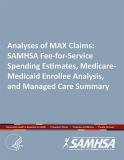
Provides behavioral health, correctional, and community stakeholders with examples of the implementation of successful strategies for transitioning people with mental or substance use disorders from institutional correctional settings into the community. Highlights prevalence of mental and substance use disorders in correctional settings.
Units per Product
Download
Guidelines for Successful Transition
File Type: PDF
File Size: 1.75 MB







